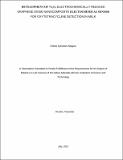Development of ta2o5 electrochemically reduced graphene oxide nanocomposite electochemical sensor for oxytetracycline detection in Milk
Abstract
Various kinds of antimicrobials are being used in the veterinary sector for therapeutic and
growth promotion purposes. Significant amounts of antimicrobial residues are released in the
milk and exert harmful effects such as allergic reactions, carcinogenicity, mutagenicity and
teratogenicity as well as disturbance of normal flora in the gastrointestinal tract. Thus,
quantification of these residues is crucial. A number of conventional detection methods that are
in application, which use chromatographic, immunological and spectroscopic techniques are
sensitive, selective and used for confirmatory test. However, most of them are costly, time
consuming, laborious and cannot provide onsite results. In addition, most of the rapid detection
tests in the market are qualitative and non-confirmatory. Hence, for quick, portable, sensitive
and cost effective detection of antimicrobials, novel detection tools are needed. In this study,
novel tantalum pentoxide-electrochemically reduced graphene oxide nanocomposites modified
glassy carbon electrode (Ta2O5-ErGO/GCE) was developed for the detection of oxytetracycline
in milk. The composition, structure and morphology of GO, Ta2O5, and Ta2O5-ErGO were
characterized by X-ray diffraction and scanning electron microscopy. Oxytetracycline
electrochemical behavior on the bare GCE, GO/GCE, ErGO/GCE, and Ta2O5-ErGO/GCE was
studied by cyclic voltammetry. The Ta2O5-ErGO/GCE showed 2 fold increased magnification
of the oxytetracycline oxidation signal in comparison to GCE, GO/GCE, ErGO/GCE electrodes.
Under the optimum conditions, the currents were proportional to the oxytetracycline
concentration in the 0.2 to 10 μM range with 0.095 μM as low detection limit. The preparation
of Ta2O5-ErGO/GCE in the current work provides an outlook for detecting ultra-trace
oxytetracycline in milk.

